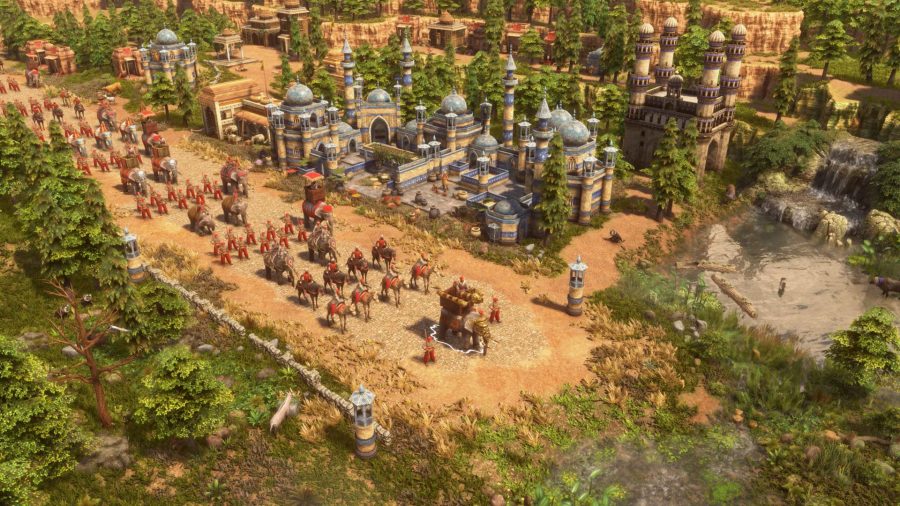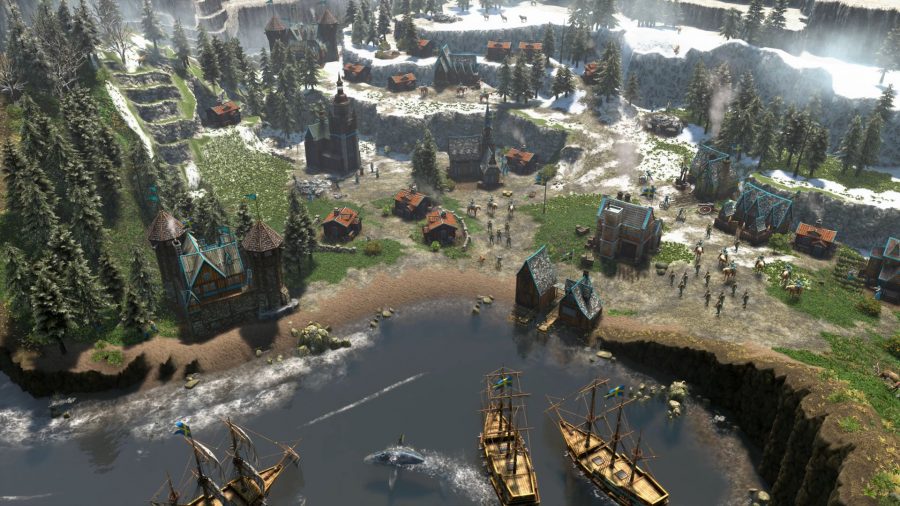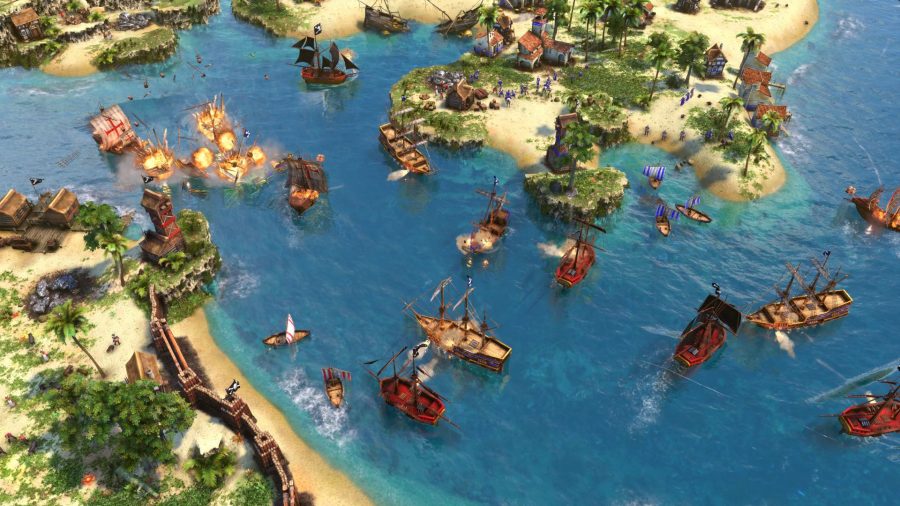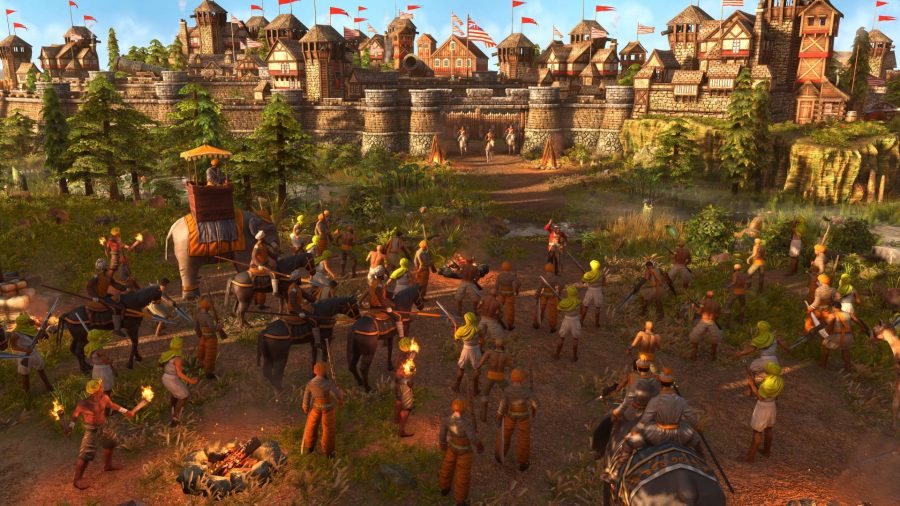Age of Empires III: Definitive Edition will, in many ways, be a world away from the 2005 RTS fans will remember. Like last year’s Age of Empires II: Definitive Edition, the upcoming PC game will feature a raft of significant tweaks and tinkerings. In this case, brand new civilisations, game modes, graphical and gameplay changes, new Art of War missions to show you the ropes, and updates to the Native American civilisation following consultation with tribal representatives.
The consideration that lies at the heart of every remaster remains, however: how to marry the spirit of the original with the look and experience of a new PC game. Developers Tantalus Media and Forgotten Empires, and publisher World’s Edge, have a tricky line to walk between delivering a nostalgic punch for the strategy game’s long-time fans and a big, shiny carrot to tempt new players on board.
To find out how the devs strike this balance, what makes this Age of Empires experience ‘definitive’, and why players old and new should dive in (clue: “You can see the cliffs!”) we spoke to creative director at World’s Edge Adam Isgreen, Forgotten Empires co-founder Bert Beeckman, and Tantalus director of development Joss Ellis.
PCGamesN: How has reception to Age of Empires II: Definitive Edition influenced Age of Empires III: Definitive Edition?
Adam Isgreen: Art of War is one of the best examples. We’ve been trying to listen to the community, be driven by what they want us to do, and what they’re responding to in our games. It’s always been our plan that, if something hit well, we’d put it into the next game. The thing I like is, not only did we move Art of War over to the new game because it’s so popular – and you can bet it’s going to show up in Age IV, as well – it’s not just the same stuff.
Some people would think if you’re going to make Art of War, it’s going to be the same [each time]. But no, that’s not the case. Art of War in Age III is specific to Age III, and will celebrate and teach you about all the nuances and deep gameplay that Age III offers.
PCGN: Age III is more modern than Ages I or II, with a fully 3D engine. How did that affect your approach to the remaster at a technical level?
Joss Ellis: Basically we looked at it and went, ‘Let’s just improve everything’. Every single model and texture has been remade. We illuminated paint textures. This one’s got advanced shaders and it’s a modern engine. It’s got little tiny touches, like when the guys walk through the grass, they leave their footprints behind them. All the physics have been redone, the multiplayer game’s been redone. We’ve completely overhauled the user interface, so it has a much more modern, floating feel. You can see much more of the game.
We’ve gone to efforts to make it work on old hardware, and yet still take advantage of super high-end hardware.
AI: This is going to sound funny, but one of the things I love most is that we fixed the cliffs! In Age III before, sometimes you could lose height with the terrain. It would just blend into each other. All the art has been redone to the point where you never lose a cliff any more, so you understand the height a lot better. For me that was a huge win. You can see the cliffs! It just makes a huge difference.
PCGN: What are the main differences between the Age II and III communities?
Bert Beeckman: The community in Age III is just like Age II: really, really dedicated. But they’ve always known that they were the smaller game compared to the rest of the series. Nonetheless, they’re extremely passionate about it, and one of the things they did by themselves was continue to balance the game. They made new maps and made sure all the content can actually be seen – there were so many units and technologies in the game, and you just never used them because they were so poorly balanced. The community took care of that for a large part.
When we worked on this, we thought we just needed to look at what the community has done. Let’s talk to all those people, involve them in this process, and make sure that all the content – or, at least, a big chunk of it – they’ve been doing over the years gets into the Definitive Edition.
PCGN: What’s your sense of what the community wants from Age III: DE, and how are you going to deliver?
AI: One of the first things we did, behind the scenes, was reach out to all the dedicated, die-hard players of Age III that have still been going and keeping the community alive. We went directly to them and said, ‘You’ve seen what we’ve done with the previous Definite Editions. What do you want?’ They generated this huge list, and I think we got almost every single request.
JE: We have the original RFP – ‘Request For Proposal’ – from Adam. I go through it and make sure every single item has been ticked off. There are hundreds of items on it. Then we circled back to the community, double-checked, and added more things. I hope we’ve done everything they asked.
AI: The cool thing is we’ve had a little more freedom with Age III than we have with Age II in terms of being a little more radical, adding things, and changing things, simply because the community was more open to it. They are a slightly smaller community than Age II’s, though still a ridiculously huge amount of people. I think because of that they’re like, ‘We want our game to be better! We want our game to be bigger!’ So there are lots of people willing to let us go a little further.
You can see that in the user interface. We have options to let you go from a classic equivalent to a modern, floating interface that looks like something out of an RTS game released today. Aside from the graphics – you don’t want ten polygon wheels on things – we give you options for turning everything off and going back to as classic a look as you can get.
PCGN: You’ve consulted with Native American tribal representatives to improve the civilisation’s depiction in the game. What changes have you made?
BB: One of the most shocking things we heard from them was in Native American history they never had gold mining or metallurgy. They didn’t really use that – and that’s a big part of Age of Empires. It’s one of the four main resources, so how do you work around that? We removed gold mining from them, but we replaced it with a mechanic of fur trading, so that’s how they get their commercial resource.
PCGN: Looking back, what’s your personal feeling on Age III? Why do you think it didn’t achieve the same long-term success as Age II?
AI: From a high-level point, Age III is a radical departure from Age I and II. If you think about what people expect of sequels, they think it’s going to be a new version of the thing they love. But Age III was not that. It was a completely different game, and that’s not to say it’s a bad game, it’s just very different. I think Ensemble Studios experimented with things that it just wouldn’t dare put into Age II. I applaud it for that. It’s cool to see it just go off in a completely different direction, but it does mean you’re going to leave a certain amount of people behind that won’t want to take the time to learn the new way to play.
JE: Personally, out of the three, it’s my favourite. I think it depends on your personality as well, and the other kinds of games that have brought you to that point.
AI: It’s got a meta card game in it. What other real-time strategy game has that? With the home cities, and making decks, they tried a lot of things, and it’s crazy! I’m glad it’s still as popular as it is, and people still find it fun and unique. Hopefully with the DE, and especially some of the things like Art of War, people will be able to get into it a little easier, and realise this is why this game is so cool.
PCGN: The addition of gunpowder units arguably made for less intricate battles – what do you think?
BB: It makes it different. This is also something that I went through as a kid – this gun counters this gun, which is a bit weird. But there are still so many counter systems and intricate interactions between all the units – this kind of cannon is good against this kind of cannon – that it may look the same on the first signs, but if you dive into it, it’s so much more complex than any other Age game out there.
PCGN: How did you choose the two new civilisations (Sweden and the Inca), and what will they bring to the mix?
BB: Sweden is interesting because it’s the first time we’ve had it in the whole franchise. When we looked at the history we realised that, although this is a small nation, it dominated the battlefields of Europe during the 17th and 18th centuries. We had to look up why that was. They were very innovative with gunpowder, with their use of cavalry and mercenaries. Those are three things we have in Age III, so let’s put that together in a civ.
That also inspired their gameplay. If you play as Sweden, you’re very aggressive, trying to get all over the map, trying to get mercenaries shipped from basically every nation in Europe at the time. It’s truly a civilisation for the hardcore Age III fans. If you love Age III, you’re going to love Sweden, because it uses everything from Age III in that one civ.
On the other hand, the Inca are more for the Age II crowd that wants to get into Age III, because it’s more of a city builder civ. You can build your huge empire, your stone walls, your palaces, your citadels, whatever you want. So we have two very different civs, with a lot of variety.
PCGN: Finally, what are your favourite things about Age III: DE?
JE: Destruction in the game is just fabulous. You never quite tire of having a whole ton of units just rolling over and destroying other people’s stuff. We made huge efforts to change the physics system to a brand new Havok system, and take what we’d already done up to eleven. It’s great, it’s really satisfying.
AI: For me, it’s probably the update on the home cities and some of the shots that you can get from them. They look like pictures you would see of these places in the past, when they were in their prime. They’re so gorgeous. I think it just adds so much to the culture of the game and to be able to identify with a civilisation, to see one of their cities in its heyday.
Everything from a Native American version of a city, which is very different to, say, the Incas. It’s awesome to see that we’ve got that scope in the game, and as someone that wants to get people excited about history, I found it fun and compelling to be able to do those.
BB: For me, one of the most exciting things is the AI improvement. I love to play against the computer and ‘comp stomp’. I noticed as we improved the AI – and we did improve it quite a bit; we added a new ‘extreme’ difficulty level – we did not make the AI cheat more. We actually reduced the number of cheats and just made it better. It can micromanage now, it’s much better at picking units, reading the map, reading its opponent’s army. I noticed when I’m playing, ‘Damn, I have to look up build orders, and figure out how to play well to now beat the best AI!’.
AI: Didn’t you guys find some serious bugs? Like, there were whole swathes of units that weren’t being used when you were digging in the code, and the AI just wouldn’t build things?
BB: Yeah, the AI basically ignored half of the content in the game! Technologies and units – it wouldn’t even look at them or consider them. Now it uses everything!
AI: We’re just really excited for new people to discover Age III. It’s funny to say that it’s not as popular as Age II because Age II is so ridiculously popular, but Age III is still popular, it’s just that fewer people have had the chance to experience it. We’re all hoping that through the Definitive Edition, people will be able to find and discover the magic of what makes Age III so great. Because it is a unique game, even among RTS games. I’ve never played an RTS that does what it does.




